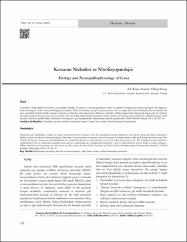| dc.contributor.author | Kıyat- Atamer, Aslı | |
| dc.contributor.author | Krespi, Yakup | |
| dc.date.accessioned | 2016-08-24T07:34:43Z | |
| dc.date.available | 2016-08-24T07:34:43Z | |
| dc.date.issued | 2012 | |
| dc.identifier.citation | Kıyat Atamer A, Krespi Y. [Etiology and Neuropathophysiology of Coma]. Türk Nöroloji Dergisi. 2012;18(4):126-134 doi:I 10.4274/Tnd.30085 | en_US |
| dc.identifier.issn | 1301-062X | |
| dc.identifier.uri | http://www.tjn.org.tr/jvi.aspx?pdir=tjn&plng=eng&un=TJN-30085&look4= | en_US |
| dc.identifier.uri | https://hdl.handle.net/11446/1074 | en_US |
| dc.description | İstanbul Bilim Üniversitesi, Tıp Fakültesi. | en_US |
| dc.description.abstract | Uyanıklık ve farkındalık neokorteksin mezensefalik retiküler formasyon ve asendan projeksiyon lifleri ile sağlıklı bir bağlantıda olmasını gerektirir. Bu bağlantıyı bozan herhangi bir neden bilinç bozukluğuna yol açabilir. Bilinç bozuklukları geniş bir spektrumda yer alır ve en ağır olanı koma tablosudur. Koma sırasında hastanın uyanıklığı ile farkındalığı tamamen kayıptır ve sirkadyen ritm saptanamaz. Komanın etiyolojisi oldukça kapsamlıdır; karşı tarafı basınç yolu ile etkileyen tek yanlı yapısal bir lezyon kadar, ilaç veya toksin gibi çift taraflı diffüz kortikal bozukluk yaratan etkenler de komaya neden olabilir. Bu derlemede yaygın koma nedenleri üzerinde spesifik olarak durulacak ve komaya yol açan fizyopatolojik mekanizmalar gözden geçirilecektir. | en_US |
| dc.description.abstract | Awareness and wakefulness require an intact connection of the neocortex with the ascending reticular formation. Any factor disrupting these pathways is likely to cause a syndrome of unconciousness. Disorders of consciousness encompass a broad spectrum of various entities with coma being the most severe form of lack of response. Awareness and wakefulness are completely absent in coma and there is no detectable sleep-wake cycle. The etiology of coma includes a comprehensive list of conditions; unilateral mass lesions compressing the contralateral hemisphere could be responsible as well as drugs or toxins leading to diffuse bilateral cortical damage. In this article specific causes of coma will be discussed and their likely pathophysiological mechanisms outlined. | en_US |
| dc.language.iso | tur | en_US |
| dc.publisher | Türk Nöroloji Derneği | en_US |
| dc.identifier.doi | 10.4274/Tnd.30085 | en_US |
| dc.rights | info:eu-repo/semantics/openAccess | en_US |
| dc.subject | uyanıklık | en_US |
| dc.subject | asendan retiküler aktivasyon sistemi | en_US |
| dc.subject | koma | en_US |
| dc.subject | beyin ödemi | en_US |
| dc.subject | beyin herniasyon sendromları | en_US |
| dc.subject | wakefulness | en_US |
| dc.subject | ascending reticular activation system | en_US |
| dc.subject | coma | en_US |
| dc.subject | brain edema | en_US |
| dc.subject | cerebral herniation syndromes | en_US |
| dc.title | Komanın nedenleri ve nörofizyopatolojisi | en_US |
| dc.title.alternative | Etiology and neuropathophysiology of coma | en_US |
| dc.type | article | en_US |
| dc.relation.journal | Türk Nöroloji Dergisi | en_US |
| dc.department | DBÜ, Tıp Fakültesi | en_US |
| dc.identifier.issue | 4 | |
| dc.identifier.volume | 18 | |
| dc.identifier.startpage | 126 | |
| dc.identifier.endpage | 134 | |
| dc.contributor.authorID | TR194327 | en_US |
| dc.relation.publicationcategory | Belirsiz | en_US |


















